Sweet, large and very fragrant Pandarose tomatoes - decoration of the garden bed
For lovers of pink tomatoes, we present the hybrid Pandarosa f1. This is a unique species that can conquer any fastidious gardener with such advantages as a non-seedling method of cultivation, good adaptation to any weather conditions, immunity to many dangerous diseases, high fruiting rates, simple agricultural technology and excellent taste of the fruit.
Despite its short existence, the tomato has won a huge number of fans and continues to conquer tomato lovers, becoming a welcome guest even in regions with short and cold summers.
Description of the variety
Indeterminate bush, plant height is 1.7-1.8 m, the leaves are large, the root system is well developed. Fruit set does not depend on temperature conditions.
This is an early ripening hybrid; 70 days pass from the moment the seeds are sowed to full ripening.
Reference. A hybrid is obtained by crossing genetically different forms.
The yield is good, 3 kg of vegetables are harvested from one plant, provided that 3-4 seedlings are planted per 1 square meter. m. Fruiting is long-lasting.
The tomato is resistant to many diseases of the nightshade family, such as blossom end rot, root rot, fusarium blight, yellow leaf curl virus, and tobacco mosaic.
Reference. The danger of fungal diseases is that they are contagious and quickly affect all plants.
The Pandarosa variety is recommended for cultivation in open ground and greenhouses.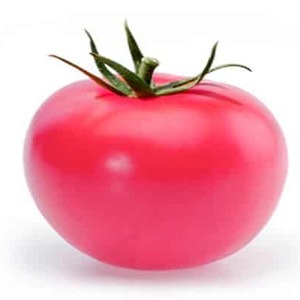
The crop requires obligatory pinching and tying due to its large growth, otherwise the branches will not support the weight of ripe vegetables.
The fruits are medium in size, their average weight is 210-230 g, they have a flat-round shape and pink color (see photo). The skin is dense, the flesh is juicy, rich in vitamins. The taste is sweet.
Vegetables can be stored and can withstand long-distance transportation for 10 days. During this time, ripe tomatoes perfectly retain their taste and appearance and do not crack.
How to grow seedlings
Sowing of seeds begins two months before planting seedlings in the ground. The soil mixture is prepared from garden soil and humus in equal quantities. The prepared soil is disinfected with a dark potassium permanganate solution.
Before sowing, seeds are treated with a growth stimulant to improve germination. The soil mixture is laid out in planting containers, filling them halfway. You can plant in a common wooden box and individual plastic or peat cups.
The grains are laid to a depth of 1.5 cm, sprinkled with soil on top and the soil is generously moistened with warm water using a spray bottle. Then the planting containers are covered with film or glass and left in a dark and warm room at a temperature of at least 23 degrees.
Reference. If the seeds are sown shallow, most of them will germinate along with the seed coat, which will noticeably slow down their further growth.
When seedlings appear, the containers are moved to a lighted place. Daylight hours for seedlings should be at least 16 hours. If there is insufficient natural light, add fluorescent lamps.
Water the seedlings moderately, without waterlogging the soil. To prevent excess moisture from retaining, holes are made at the bottom of the planting containers. Water only with warm, settled water along the edge of the nursery with a shallow watering can. After watering, loosen the soil with a regular fork or wooden stick. This procedure improves the air permeability of the soil, which promotes the full development of sprouts.
When two true leaves appear, the seedlings dive, planting them in separate containers. During this period, you can apply the first mineral supplement.
Reference. After picking, the seedlings are more adapted to transplanting into open ground.
10 days before planting in a permanent place, seedlings begin to adapt to open ground conditions by hardening off the seedlings. To do this, it is taken out into the open air for 30 minutes, gradually increasing the stay time to several hours. At the same time, the night temperature in the room where the seedlings are brought is reduced to 14 degrees.
How to grow tomatoes
After two months, the seedlings are ready to be transplanted to a permanent location. First, dig up the soil for tomatoes and make small holes no more than 15 cm deep. It is best to replant on a cloudy day or in the evening, since the vegetable crop does not like direct sunlight and it will be more difficult for it to adapt to new conditions under unfavorable factors.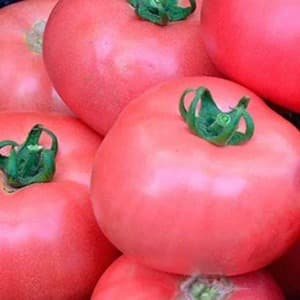
Planting pattern: 60 cm – distance between seedlings, 40 cm left between rows, per 1 sq. m place 3-4 plants.
After transplanting, the holes are moderately watered with warm, settled water, the soil is loosened and hilled up. Within a week, the young bushes get used to the new place.
Regular watering installed as soon as the seedlings finally take root and begin to grow.Water moderately with warm, settled water, strictly at the root, without getting on the leaves. For this variety, drip irrigation is the best option for moistening the soil.
After watering, the soil is loosened, hilled and mulch. Mulching retains moisture in the beds longer and prevents the penetration of many pests.
First feeding carried out 7-10 days after transplantation. Feed with a full range of mineral fertilizers or organic matter (mullein infusion or bird droppings). They also use an infusion of weeds, which is left to ferment in the sun for a week. Organic matter is diluted in a bucket of water in a ratio of 1:15.
Culture requires mandatory regular stepsons And tying tall plants. Wooden stakes or metal rods are installed next to each bush as a support. The seedlings are tied to the support immediately when transplanted to a permanent place. As the branches grow, they are also tied to supports so that they do not break from the weight of ripe fruits.
They form a culture in one, two or three trunks, depending on the regionwhere it grows. In the southern regions, the plant is grown in one or two trunks, and in the northern regions more stepsons are left for better fruiting.
Diseases and pests
This variety of tomatoes is immune to diseases dangerous to the nightshade family (these include cladosporiosis, yellow leaf curl, fruit blossom end rot, verticillium blight, root rot, fusarium wilt). Some of them are of viral etiology, while others belong to fungal species. The creators of the hybrid inserted immunity into genes that can resist both viral and fungal infections.This is undoubtedly a huge plus of the crop, which makes it increasingly popular among gardeners.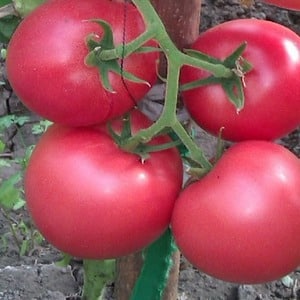
Nevertheless, a reminder of preventive measures will not be superfluous, even if we are talking about such a disease-resistant type of tomato.
Prevention includes compliance with the basic rules of crop rotation and agricultural technology. Planting tomatoes in soil that is enriched with vitamins and minerals allows the plants to receive all the necessary nutrients that promote full growth and development. Moderate watering and timely loosening are the same necessary preventive measures as spraying plants with decoctions of fragrant herbs.
If you water on time and correctly, the roots will not rot from excess moisture, and dry leaves, unlike wet ones, will not get sunburned. As for loosening, it improves the air permeability of the soil and prevents the appearance of pests living underground. Mulching beds also performs a similar function.
Spraying, for example, with burdock decoction prevents the appearance of whiteflies, since they do not like this smell. To combat it, pheromone traps are also used, which are intended only for flying pests, without causing harm to other insects.
Soap solutions protect against aphids and prevent slugs from moving freely along the stem, making it slippery.
Regular inspection of bushes for the presence of parasitic insects prevents their further spread.
The nuances of growing in open ground and greenhouses
The main difference between this tomato crop and others is that it can be grown not only by seedlings, but also without seedlings. Seeds are planted to a depth of 5 cm in open ground when the soil warms up to 10-12 degrees.The main thing is to protect the crop from drafts, otherwise the young bushes will not grow into healthy and strong plants.
The variety has fairly strong immunity against many diseases and is not susceptible to attacks by insect pests. However, until the bushes get stronger, it is necessary to regularly inspect them for the presence of parasites that like to feast on young greenery.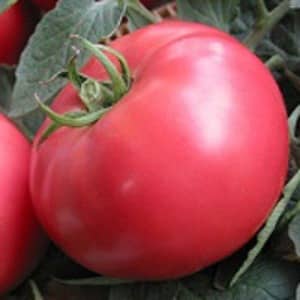
When planting seeds in open ground observance of crop rotation rules is mandatory: This not only leads to good quantitative results, but also keeps the plants strong and healthy throughout the growing season.
If you plant a tomato in the ground where winter grains, legumes, cabbage or carrots previously grew, this will have a beneficial effect on the crop. Such precursors do not draw nutrients from the soil that are necessary for the growth and development of tomatoes.
When growing crops in greenhouse conditions, it is necessary to regularly ventilate closed structures. This is due to the fact that the habitat of many harmful insects and fungal infections is greenhouse. A regular supply of fresh air destroys the pathogenic environment, and the likelihood of disease occurrence is significantly reduced.
The height of greenhouse bushes differs from those growing in open beds. To limit growth, the crown of greenhouse plants is pinched. The lower leaves are removed, as they are constantly in contact with moisture in the beds. Being always wet, they can rot, which will lead to the spread of fungal spores.
Harvesting and application
Collection begins from the end of June - beginning of July. Ripe vegetables are picked one at a time, as they do not ripen together, not in whole clusters. The fruiting of the crop is extended, which makes it possible to consume fortified ripe vegetables for a long time.
The species belongs to the salad category, so its main purpose is to eat fresh. The fruits are great for a variety of salads, appetizers, hot and vegetable dishes. They do not lose their taste when baked with meat.
They are also suitable for canning in pieces. Sometimes, for a variety of colors, pink vegetables are mixed with red ones, which looks very colorful and appetizing.
Tomatoes are processed into tomato products: juices, ketchups, pastes.
Ripe vegetables cannot be stored for long-term storage.. They are recommended to be used within 10 days. Otherwise, they will not retain their marketable appearance and will lose their taste.
Advantages and disadvantages
Despite its not entirely universal use in cooking, Pandarose has enough positive characteristics that can interest many tomato lovers: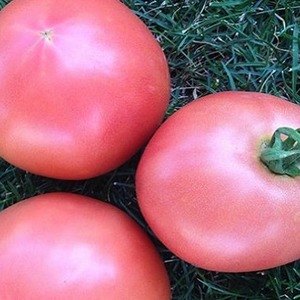
- possibility of propagation without seedlings;
- ease of care;
- immunity to diseases and pests;
- high fruiting rate;
- good adaptation to any weather conditions;
- excellent taste and color of vegetables;
- commercial appearance.
The disadvantages include the following:
- the plant requires pinching and gartering;
- fruits cannot be stored for long periods of time;
- seeds do not retain parental genes.
Farmer reviews
Tomato Pandarose, despite its short lifespan, has managed to accumulate many trustworthy reviews into its collection of positive qualities. Most gardeners grow only pink tomatoes on their plots, experimenting with new varieties every year.But this hybrid managed to conquer many vegetable growers, remaining on their plots from year to year.
We present you a couple of reviews from fans of the variety:
Margarita, Tyumen: “I grow a hybrid in a greenhouse using seedlings. The plants are usually strong, tall, and bear many fruits on the clusters. At the ripe stage, they acquire a pleasant raspberry color and sweet taste. I use fresh tomatoes to make salads.”
Mikhail, Adler: “The hybrid was grown directly in the soil. During the entire period, powerful bushes formed. I specially prepared a bed for tomatoes in the fall and added a lot of organic fertilizers. I was impressed by the culture’s resistance to viruses and fungi, long-term fruiting and excellent taste. Used fresh. Next season I will definitely plant the hybrid again.”
Conclusion
The Pandarose f1 tomato is unique for its strong immunity and the ability to grow without seedlings. These factors will undoubtedly attract the attention of many tomato lovers. And if the crop is also high-yielding, unpretentious in care and well adapted to any weather conditions, then, undoubtedly, it will become a favorite among other types of tomatoes in summer cottages.